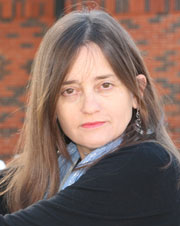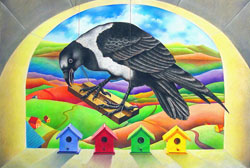A Time of Protection, Lithographs & Drawings by
Katherine Liontas-Warren
North Gallery - December 20 - February 20, 2011

Liontas-Warren began drawing at an early age. She had her first experience with lithography as an undergraduate student at Southern Connecticut State University. She says, "I was immediately taken by this beautiful method of drawing on a stone." From then on, she says, "I was determined to be a lithographer." She continued to study lithography in graduate school at Texas Tech and began her career in art as a visiting artist at Cameron University in Lawton. In 1984, she became a professor of drawing and printmaking at Cameron and continues to teach the process there today.


Liontas-Warren is a member of numerous professional organizations including Oklahoma Visual Arts Coalition; National Museum of Women in the Arts, Washington, D.C.; Inkteraction: International Printmakers, Virtual Gallery; and Individual Artists of Oklahoma, Oklahoma City. In November, Liontas-Warren was named the 2010 Artist of the Year by the Paseo Arts Association.
The Process of Lithography

Many prints of the drawing on the stone may be produced. The total number of prints made is referred to as the "edition." The edition number is the bottom number in the fraction written below each print. The top number refers to the order in which that specific print was produced. For instance, 1/20 is the first print out of twenty total prints while 10/20 is the tenth out of twenty. The order is important because the image on the stone will degrade with use. The first prints are often the crispest and therefore most in demand.
The earliest form of printmaking occurred in China during the 9th century. Over the centuries the practice has continued to develop as both a method of reproduction as well as an art form in itself.
Reproductive prints replicate a work created in another medium, such as drawing and painting. This kind of print was widely used from the 16th century until the invention of photography in the 19th century. The reproductive print was used as a form of reference to ensure consistency in representations such as religious or biblical scenes. Art was the way to record history and making prints of the art allowed people to collect recorded history.
Upon the invention of photographic techniques in the 19th century, the expense and time consumption of lithography was no longer the leading method for reproduction. Around this time, artists began using printmaking as an art form. Prints that are created as an original composition rather than a copy of another artwork are called original or fine prints. The prints included in this exhibit by Katherine Liontas-Warren are original prints.
